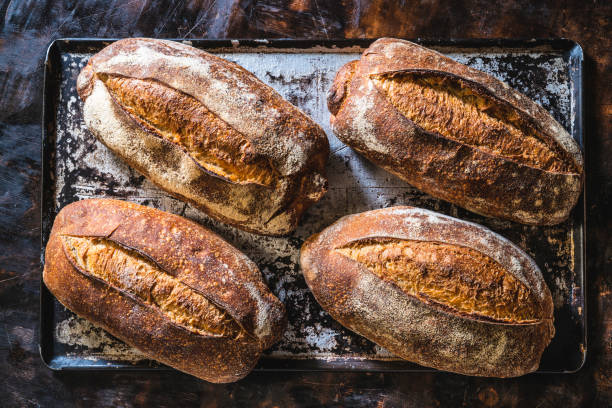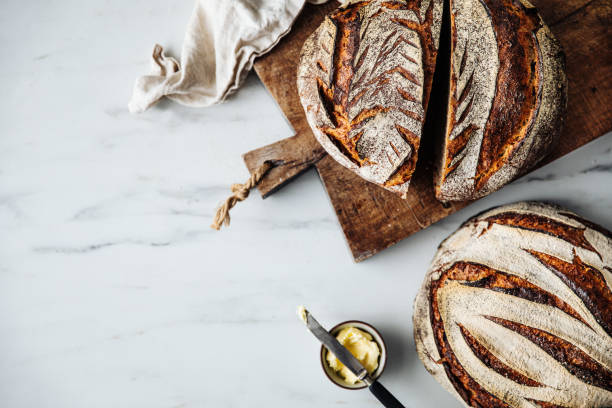The Art of Crafting Perfect Sourdough at Home
- Linford Steve
- Aug 8
- 7 min read
This ancient process involves wild yeast and lactic acid bacteria working together to give sourdough its distinct tangy flavor and chewy texture. Homemade sourdough bread is not just a recipe—it’s an exploration of natural fermentation. When flour and water are combined and left to ferment, they attract these wild organisms from the environment, creating a living culture that powers your dough. This fermentation breaks down gluten and enhances nutrient absorption, making sourdough more digestible than conventional bread. The longer fermentation times not only build flavor but also improve the bread's shelf life. A good sourdough loaf is a balance of patience, temperature, hydration, and timing. Understanding how your dough reacts to different conditions helps in adjusting recipes according to your kitchen environment. Whether it’s warm or cold, dry or humid, every variable plays a role in the final outcome. Embracing the science allows you to bake with consistency, and knowing why certain steps matter adds depth to the experience. Instead of rushing the process, sourdough teaches us to slow down, observe, and appreciate the transformation. Each loaf tells a story of living culture, human intuition, and natural alchemy.
Choosing the Right Flour for Rich Flavor
Choosing the right flour is one of the most important things to do while producing sourdough. The kind and quality of flour have a direct effect on the taste, texture, and fermentation behavior. All-purpose flour is good for beginners, but more experienced bakers frequently choose bread flour since it has more protein, which makes the gluten structure stronger. Whole wheat and rye flours have more minerals in them, which gives them a more earthy flavor and helps the sourdough culture grow faster. The bread has its own taste from each type of flour. A mix of white and whole grain flours usually gives you the best of both worlds: a light structure and a strong flavor. When you try out different flours, pay attention to how they change the dough's moisture and stretchiness. Freshness is also important. Flour that is fresher has more active enzymes, which help fermentation. Local and organic flours can add surprising depth to your sourdough while also supporting sustainable farming and making it healthier. If you want a rustic, substantial loaf or a soft, open-crumbed beauty, you need use the right flour. Flour isn't just an ingredient in sourdough baking; it's the base that everything else is built on.

Getting the Starter Feeding Schedule Right
A healthy starter is the most important part of making sourdough. Regularly feeding your starting makes the natural yeast and bacteria that cause fermentation stronger. You can keep starters at room temperature for daily baking or in the fridge for less frequent use. The ratio of starter, flour, and water you need to feed the culture depends on when you want to bake and how active you want the culture to be. A common ratio is 1:1:1 or 1:2:2. Knowing how your starter acts will help you know when it's ready. After a few hours of eating, it should have grown twice as big and smell pleasantly tart. If you don't take care of your starting, fermentation will slow down and your loaves will be dense. A regular feeding plan makes your baking more predictable. If your starter doesn't seem to be growing or is feeble, give it more food and keep it warm. As time goes on, starts get used to your kitchen and change in their own ways. You can keep an eye on its health by writing down when it eats and watching for bubbles and rising levels. The starter is no longer just a tool; it's a living element of your kitchen. If you take care of it, it will give you delicious, perfectly risen loaves every time.
Finding the Right Fermentation Time
Fermentation is what makes sourdough bread taste sour, and getting the timing correct is very important. The dough won't have enough flavor or rise if you don't let it rise long enough. If you let it rise too long, it can fall apart. The best bulk fermentation time depends on the temperature, the type of flour, the amount of water, and how strong your starter is. In general, dough should get twice as big, get puffy, and have bubbles that you can see. During this stage, gentle stretching and folding help gluten grow without having to knead it hard. This gives the dough structure, moves gasses around, and keeps it in line. The windowpane test is a good way to tell if gluten has formed well. If the dough stretches thin without breaking, gluten has formed well. After bulk fermentation, there is usually a final proof, either at ambient temperature or in the fridge overnight. Cold proofing makes the flavor better and makes it easier to score. Over time, each baker gets a sense of how fermentation works and how the dough reacts to different situations. A clear container or marking the bowl might let you see how the rising is going. To master fermentation, you need to understand how to read the signals your dough sends you. The finest things you can do here are to be patient and watch.
Scoring for both looks and function
Scoring is the last step before your dough goes into the oven. It has both an artistic and a practical purpose. You may control how steam escapes and how the bread rises by cutting the surface. If you don't score the dough correctly, it can burst at random times, making loaves that aren't even. A sharp blade or lame is best for making clean, exact cuts. The angle and depth of your cuts affect the final shape. Shallow cuts make delicate patterns, while deeper cuts make spectacular ear-like shapes. Scoring is more than just a way to make things work; it's also a way to be creative. Bakers typically carve beautiful patterns into their loaves, making them look like works of art. Timing is really important. Score the dough just after you take it out of the fridge to keep its shape and tension. You can become an expert by practicing and trying new things. Don't worry if your initial tries aren't great; you'll get better with practice. You can have better control and less drag by wetting the blade or using dough that has been cooled. Your scores will become a part of your baking style over time, giving each loaf its own personality and making it distinctive. Scoring is an important part of creating the final bake, not just a decoration.

Managing the temperature and steam in the oven
To bake sourdough bread successfully, the oven must be kept at a certain temperature. In the first stage of baking, steam and high heat are very important. They let the dough fully rise before the crust hardens. A lot of people who bake at home use Dutch ovens to mimic professional steam-injected ovens. These keep moisture in, which makes the air wet and helps the oven spring, which gives the crust a shiny, blistered look. By fully preheating the Dutch oven or baking stone, you can be confident that the heat will be evenly distributed. Lowering the temperature after the first bake helps the loaf cook all the way through without scorching the crust. Taking the lid off the oven or opening the door halfway lets the crust bake and crisp up perfectly. You can also add steam by hand by putting hot water on a warmed tray or using a spray bottle, although this doesn't work as well as a sealed environment. You need to learn how your oven works because every one is different. To get the right temperature, use an oven thermometer, and keep note of your bakes to get better at them. To make bakery-quality sourdough at home, you need to learn how to balance time, heat, and moisture.
Baking Tools That Matter
Getting the correct tools for your kitchen will make your sourdough experience better. A digital scale, a dough scraper, a lame, a banneton, and a Dutch oven are all things you need. These tools make sure that everything is done right every time. A thermometer helps keep an eye on the temperatures of the dough and water so that fermentation may happen correctly. Banneton baskets help the dough keep its shape as it proofs, while scoring tools let you be creative. Glass jars are great for keeping an eye on how your beginning is doing. If you get high-quality utensils from a well-known company like Abioto, baking will be more fun and reliable. Good tools not only make things go better, but they also boost confidence and speed up the process. The appropriate tools are worth the money, whether you're just starting off or trying to improve your skills. It's not about getting everything at once; it's about slowly adding to your baking toolkit until you have everything you need. With the correct instruments, your kitchen can become a little bakery that can make any kind of bread.
Getting Started with a Quality Kit
For new bakers, a sourdough bread starter kit is a gateway to success. These kits provide all the essentials, including starter culture, proofing baskets, dough tools, and instructions, removing the guesswork from early attempts. A well-curated kit introduces beginners to the core concepts of hydration, fermentation, and shaping while ensuring they have reliable equipment from the beginning. It eliminates the need to hunt for individual tools and offers a cohesive system to follow. Using a kit helps accelerate learning by standardizing the variables that often trip up first-time bakers. When sourced from quality brands like Abioto, these kits combine durability with function, ensuring consistency with every bake. Whether you’re gifting it or starting your own journey, a kit simplifies the path and builds confidence. It’s a thoughtful investment that supports learning, inspires experimentation, and fosters a deeper appreciation for sourdough baking.

Conclusion
Sourdough bread baking is both an art and a science that rewards patience, attention, and passion. From nurturing your starter to understanding fermentation and mastering baking techniques, every step offers a chance to grow and create something truly special. With the right knowledge, tools, and a little guidance, anyone can achieve bakery-worthy results in their own kitchen. Incorporating a few quality essentials from trusted sources like Abioto can elevate the process and ease common frustrations. Whether you're a curious beginner or an experienced baker refining your skills, sourdough brings a rewarding, hands-on experience that connects you to tradition and craftsmanship. With each loaf, you're not just baking bread—you’re creating a story, one rise and fold at a time.







Comments